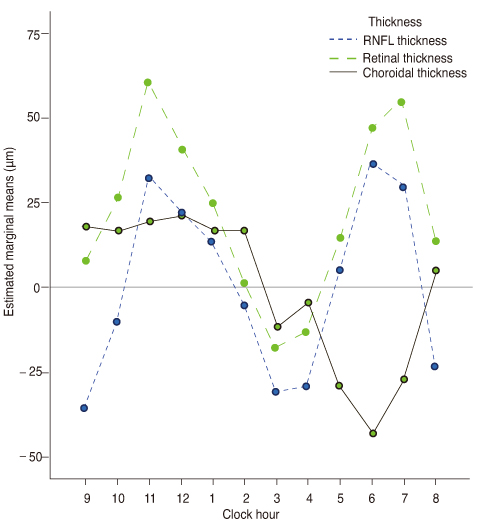Korean J Ophthalmol.
2013 Jun;27(3):172-177. 10.3341/kjo.2013.27.3.172.
Simplified Method to Measure the Peripapillary Choroidal Thickness Using Three-dimensional Optical Coherence Tomography
- Affiliations
-
- 1Department of Ophthalmology, Korea University College of Medicine, Seoul, Korea. ojr4991@yahoo.co.kr
- 2Department of Biostatistics, Korea University College of Medicine, Seoul, Korea.
- KMID: 1798054
- DOI: http://doi.org/10.3341/kjo.2013.27.3.172
Abstract
- PURPOSE
To evaluate a simplified method to measure peripapillary choroidal thickness using commercially available, three-dimensional optical coherence tomography (3D-OCT).
METHODS
3D-OCT images of normal eyes were consecutively obtained from the 3D-OCT database of Korea University Medical Center On the peripapillary images for retinal nerve fiber layer (RNFL) analysis, choroidal thickness was measured by adjusting the segmentation line for the retinal pigment epithelium to the chorioscleral junction using the modification tool built into the 3D-OCT image viewer program. Variations of choroidal thickness at 12 sectors of the peripapillary area were evaluated.
RESULTS
We were able to measure the peripapillary choroidal thickness in 40 eyes of our 40 participants, who had a mean age of 41.2 years (range, 15 to 84 years). Choroidal thickness measurements had strong inter-observer correlation at each sector (r = 0.901 to 0.991, p < 0.001). The mean choroidal thickness was 191 +/- 62 microm. Choroidal thickness was greatest at the temporal quadrant (mean +/- SD, 210 +/- 78 microm), followed by the superior (202 +/- 66 microm), nasal (187 +/- 64 microm), and inferior quadrants (152 +/- 59 microm).
CONCLUSIONS
The measurement of choroidal thickness on peripapillary circle scan images for RNFL analysis using the 3D-OCT viewing program was highly reliable and efficient.
MeSH Terms
Figure
Reference
-
1. Spaide RF, Koizumi H, Pozzoni MC. Enhanced depth imaging spectral-domain optical coherence tomography. Am J Ophthalmol. 2008. 146:496–500.2. Fujiwara T, Imamura Y, Margolis R, et al. Enhanced depth imaging optical coherence tomography of the choroid in highly myopic eyes. Am J Ophthalmol. 2009. 148:445–450.3. Manjunath V, Taha M, Fujimoto JG, Duker JS. Choroidal thickness in normal eyes measured using Cirrus HD optical coherence tomography. Am J Ophthalmol. 2010. 150:325–329.e1.4. Maul EA, Friedman DS, Chang DS, et al. Choroidal thickness measured by spectral domain optical coherence tomography: factors affecting thickness in glaucoma patients. Ophthalmology. 2011. 118:1571–1579.5. Ho J, Branchini L, Regatieri C, et al. Analysis of normal peripapillary choroidal thickness via spectral domain optical coherence tomography. Ophthalmology. 2011. 118:2001–2007.6. Shin JW, Shin YU, Lee BR. Choroidal thickness and volume mapping by a six radial scan protocol on spectral-domain optical coherence tomography. Ophthalmology. 2012. 119:1017–1023.7. Danesh-Meyer HV, Boland MV, Savino PJ, et al. Optic disc morphology in open-angle glaucoma compared with anterior ischemic optic neuropathies. Invest Ophthalmol Vis Sci. 2010. 51:2003–2010.8. Hood DC, Anderson SC, Wall M, Kardon RH. Structure versus function in glaucoma: an application of a linear model. Invest Ophthalmol Vis Sci. 2007. 48:3662–3668.9. Contreras I, Rebolleda G, Noval S, Munoz-Negrete FJ. Optic disc evaluation by optical coherence tomography in nonarteritic anterior ischemic optic neuropathy. Invest Ophthalmol Vis Sci. 2007. 48:4087–4092.10. Contreras I, Noval S, Rebolleda G, Munoz-Negrete FJ. Follow-up of nonarteritic anterior ischemic optic neuropathy with optical coherence tomography. Ophthalmology. 2007. 114:2338–2344.11. Ehrlich JR, Peterson J, Parlitsis G, et al. Peripapillary choroidal thickness in glaucoma measured with optical coherence tomography. Exp Eye Res. 2011. 92:189–194.12. Ikuno Y, Kawaguchi K, Nouchi T, Yasuno Y. Choroidal thickness in healthy Japanese subjects. Invest Ophthalmol Vis Sci. 2010. 51:2173–2176.13. Tanabe H, Ito Y, Terasaki H. Choroid is thinner in inferior region of optic disks of normal eyes. Retina. 2012. 32:134–139.
- Full Text Links
- Actions
-
Cited
- CITED
-
- Close
- Share
- Similar articles
-
- Choroidal Thickness in Primary Open-Angle Glaucoma Using Spectral-Domain Optical Coherence Tomography
- The Relationship among Refractive Power, Axial Length and Choroidal Thickness Measured by SD-OCT in Myopia
- Availability of Optical Coherence Tomography in Diagnosis and Classification of Choroidal Neovascularization
- Choroidal Thickness at the Outside of Fovea in Diabetic Retinopathy Using Spectral-Domain Optical Coherence Tomography
- Thicknesses of Macular Retinal Layer and Peripapillary Retinal Nerve Fiber Layer in Patients with Hyperopic Anisometropic Amblyopia



